Potřebujeme váš souhlas k využití jednotlivých dat, aby se vám mimo jiné mohly ukazovat informace týkající se vašich zájmů. Souhlas udělíte kliknutím na tlačítko „OK“.
ASTM E603-13
Standard Guide for Room Fire Experiments
Automaticky přeložený název:
Standardní příručka pro Room Fire experimenty
NORMA vydána dne 1.8.2013
Informace o normě:
Označení normy: ASTM E603-13
Poznámka: NEPLATNÁ
Datum vydání normy: 1.8.2013
Kód zboží: NS-47381
Počet stran: 20
Přibližná hmotnost: 60 g (0.13 liber)
Země: Americká technická norma
Kategorie: Technické normy ASTM
Kategorie - podobné normy:
Anotace textu normy ASTM E603-13 :
Keywords:
burning characteristics, experiment design, flashover guide, full-scale test, guide, ignition, instrumentation, room fire experiment, ventilation, ICS Number Code 13.220.50 (Fire-resistance of building materials and elements)
Doplňující informace
| Significance and Use | ||||||||||||||||||||||||||||||||||||||||||||||||
|
5.1 This guide provides assistance for planning room fire tests. The object of each experiment is to evaluate the role of a material, product, or system in the fire growth within one or more compartments. 5.2 The relationship between laboratory fire test methods and actual room fires can be investigated by the use of full-scale and reduced-scale experiments. This guide is aimed at establishing a basis for conducting full-scale experiments for the study of room fire growth. 5.3 Room fire tests can be placed into four main categories: reconstruction, simulation, research and standardization. 5.3.1 Reconstruction room fire tests are full scale replicates of a fire scene with the geometry, materials, contents, and ignition source intended to duplicate a particular scenario. The usual purpose of such a test is to evaluate what happened or what might happen in such a scenario. 5.3.2 Simulation room fire tests are comparable to reconstruction fire tests, except that not all of the parameters are duplicated. A simulated fire test is one in which one or more components of a fire scenario are altered, usually in order to facilitate conducting the test. The compartment design must carefully address geometry and materials of construction to ensure that they do not significantly alter the fire response. Reconstruction and simulation fire tests often have a distinctive objective, such as time to flashover, that is related to the nature of the original fire scene. 5.3.3 Research room fire tests are conducted in order to elucidate the effects of one or more of the following: geometry, materials, placement of items, ventilation, or other parameters. The measured effects (such as room temperature, heat flux, heat release rate, time to flashover, post flashover conditions) are chosen to provide the most useful information. 5.3.4 Standardization room fire tests include scenarios that have been adopted by a standardization body. In this case, the compartment, ignition source, instrumentation and the nature of the contents are specified. The purpose of such a test is often the evaluation of a specific fire test response parameter. Simplified geometries and materials of construction are selected, party because the compartment is intended to be used repeatedly. Either simulated or actual commercial test objects are specified. The geometry of the compartment is generally specified to allow well-ventilated burning of the contents, with minimal radiative feedback, and to permit observation of flame spread. In most standardized fire tests, flashover is a termination point for the test. 5.3.5 In all cases, the room lining materials should be chosen carefully. Short duration fire response tests that do not reach flashover may be less affected by lining materials than longer duration fire tests that are intended to go to flashover. The thermal properties of the lining material (emissivity, thermal conductivity, thermal inertia) should be considered. The three main variables in compartment design must be considered for any of the types of room size fire tests: ventilation, geometry, and compartment materials (see Section 1.1 This guide addresses means of conducting full-scale fire experiments that evaluate the fire-test-response characteristics of materials, products, or assemblies under actual fire conditions. 1.2 It is intended as a guide for the design of the experiment and for the use and interpretation of its results. The guide is also useful for establishing laboratory conditions that simulate a given set of fire conditions to the greatest extent possible. 1.3 This guide allows users to obtain fire-test-response characteristics of materials, products, or assemblies, which are useful data for describing or appraising their fire performance under actual fire conditions. 1.3.1 The results of experiments conducted in accordance with this guide are also useful elements for making regulatory decisions regarding fire safety requirements. The use for regulatory purposes of data obtained from experiments conducted using this guide requires that certain conditions and criteria be specified by the regulating authority. 1.4 The rationale for conducting room fire experiments in accordance with this guide is shown in 1.5 Room fire experiments are a means of generating input data for computer fire models and for providing output data with which to compare modeling results. 1.6 One of the major reasons for conducting room fire experiments is as an experimental means of assessing the potential fire hazard associated with the use of a material or product in a particular application. This should be borne in mind when designing nonstandard experiments. 1.7 A rationale for conducting room fire experiments is the case when smaller-scale fire tests inadequately represent end-use applications. 1.8 A further rationale for conducting room fire experiments is to verify the results obtained with smaller scale tests, to understand the scaling parameters for such tests. 1.9 Room fire tests can be placed into four main categories: reconstruction, simulation, research, and standardization. 1.10 This standard is used to measure and describe the response of materials, products, or assemblies to heat and flame under controlled conditions, but does not by itself incorporate all factors required for fire hazard or fire risk assessment of the materials, products, or assemblies under actual fire conditions 1.11 This standard does not purport to address all of the safety concerns, if any, associated with its use. It is the responsibility of the user of this standard to establish appropriate safety and health practices and determine the applicability of regulatory limitations prior to use. |
||||||||||||||||||||||||||||||||||||||||||||||||
| 2. Referenced Documents | ||||||||||||||||||||||||||||||||||||||||||||||||
|
Podobné normy:
Historická
1.10.2013
Historická
1.8.2012
Historická
15.5.2013
Historická
1.1.2011
Historická
1.2.2010
Historická
1.8.2010
Odebírejte informace o nově vydaných normách ZDARMA:
Chcete pravidelně odebírat informace o nově vycházejících normách z celého světa a to zcela zdarma?
Přihlašte se k odběru. Vše je velice jednoduché a absolutně ZDARMA.
Na výběr máte vydavatele z celého světa.


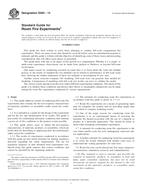
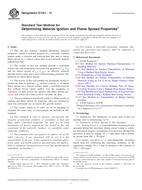 ASTM E1321-13
ASTM E1321-13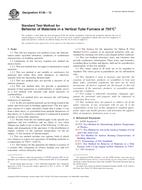 ASTM E136-12
ASTM E136-12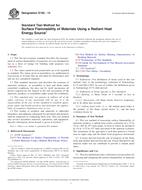 ASTM E162-13
ASTM E162-13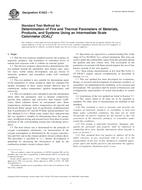 ASTM E1623-11
ASTM E1623-11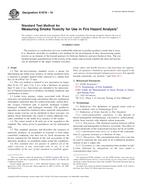 ASTM E1678-10
ASTM E1678-10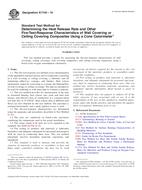 ASTM E1740-10
ASTM E1740-10
 Cookies
Cookies
